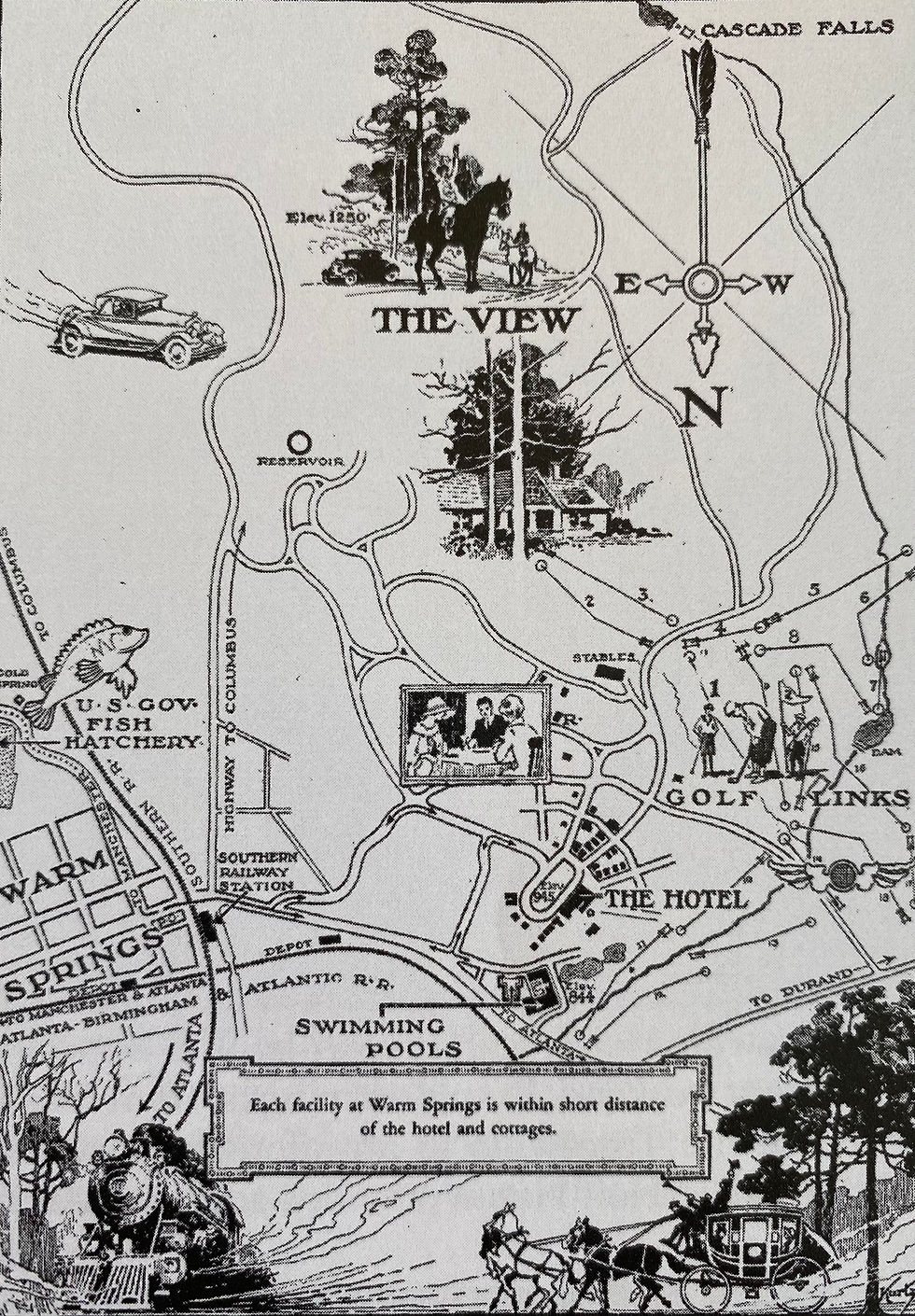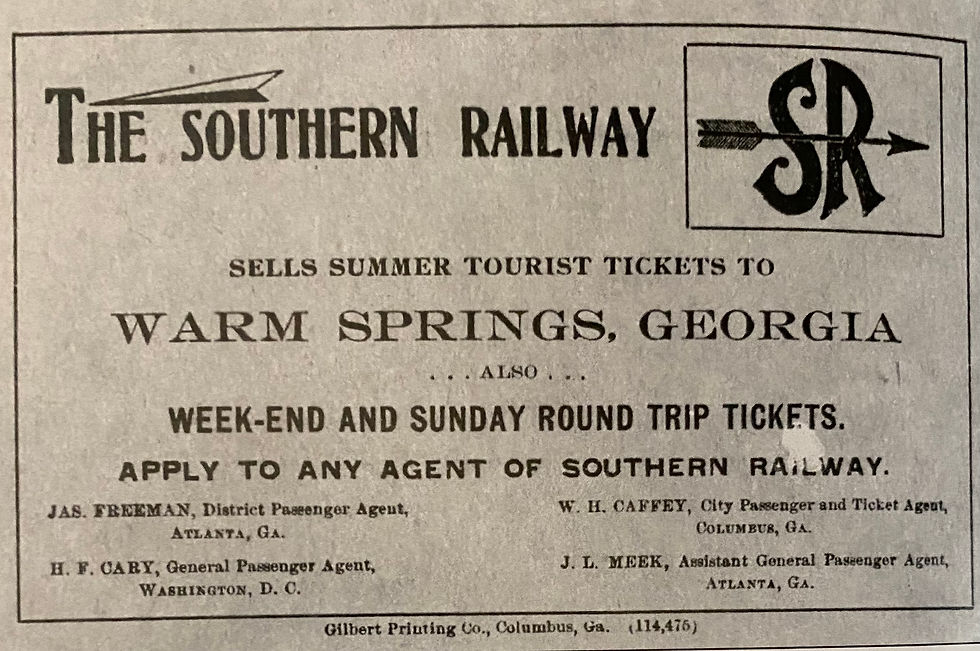Warm Springs: A Rendezvous with Destiny (Part 1 of 3)
- Historic Columbus
- Dec 2, 2021
- 7 min read
Sources include: Warm Springs by David M. Burke and Odie A. Burke and West Central Georgia in Vintage Postcards by Gary L. Doster.
From the earliest of days in its history, the warm waters that burst forth from Pine Mountain have provided a spirit of healing to all who have used them. By taking a closer look at the little-recorded events around the springs, one would discover the legends of Native Americans using the springs as a source of healing. As Europeans learned of the warm natural baths, the development of hotels and taverns took place, drawing upon the springs’ therapeutic qualities as a source of income. In the 20th century, a man stricken by polio would hear of the mysterious healing qualities of the springs and the legends and would see a cure for his polio within them. Though he would not find a cure, Franklin Roosevelt would become a catalyst from which the springs’ natural course would be altered. Along with this change, the course of history would also be altered. As if the springs had a life of their own, they used Roosevelt to become a beacon of hope in the mind of millions.

Pine Mountain, old and word down by millennia, sits in the middle of west central Georgia. On its flank is the Towaliga fault line. Occasionally it moves as the continental plates adjust themselves to pressures deep from underground. For all practical purposes, the fault has gone to sleep forever. The Towaliga has solidified to become a wall of granite. Geological reports state that the rain falling on Pine Mountain takes many paths through the earth. One path runs through the mountain, bursting out as Cols Springs. Another path becomes iron-rich Chalybeate Springs. Not far from there are White Sulphur, Yellow Sulphur, and Black Sulphur Springs. It is the Warm Springs, however, that gained popularity over the course of centuries. There are seven warm springs in the region that stretches from Pine Mountain to Barnesville, Georgia. They are Taylor Spring, Parkman Spring, Brown’s Spring, Thundering Spring, Lifsey Spring, Baker Spring, and the biggest of them, Warm Springs.

The warm springs formed natural pools or ponds of water before any man-made pools were established. In the dead of winter, the ecosystem could thrive with the warm flowing water, keeping the ground temperature near the edge warm enough to support tender grasses and other vegetation. Tadpoles can be found swimming on the coldest of days, while light wisps of stream rise above the waters, giving the only clue that winter is in full force.

As Europeans and Native Americans met, conflicts developed, and many skirmishes ensued in the New World territories. The Creek tribe occupied the area of Western Georgia, and legend states that enemies who sought the warm springs were granted safe passage through the lands. Warriors wounded from battles used the springs for its healing qualities. A kindred spirit of peace was felt among adversaries, thus giving birth to what would become known decades later as “The Spirit of Warm Springs.” Only general references support these legends. There is neither archeological evidence nor are there any eyewitness accounts of Native Americans using the warm springs. The conflict between Native Americans and settlers would continue as the colonies were formed. This clash would ultimately lead to the Native Americans being kicked out of the states of the young nation. The Treaty of 1825, signed at Indian Springs by Chief William McIntosh, gave Georgians the Native American lands as they were to be sent west. The Trail of Tears that began in Georgia ended in the western territories of Oklahoma.


The vacuum left from the departing Creeks was quickly filled with settlers seeking a new life. The land covered by the treaty was disposed of by state lottery, and in 1827, five new counties were created. One of them was Meriwether County named for General David Meriwether of Revolutionary War fame. With the fate of the Native Americans decided, new landowners settled on the slopes of Pine Mountain. As fate would have it, the first owners of Warm Springs were orphans.
(Pictured to the right is the land lottery certificate for Barton S. Park, an orphan from Putnam County, and a group of orphans from neighboring Baldwin County.)
When Meriwether County was created in 1827, settlement began immediately. Warm Springs was incorporated with three commissioners. David C. Rose, Joseph Andrews, and Charles Harris were to “oversee the bell being of its inhabitants and visitors.” Rose acquired the warm springs in 1832 and began development. He constructed larger buildings that were offered as lodging and could sufficiently handle 200 guests. In 1844, ownership of the resort changed hands to Col. Seymour Bonner. He further developed the property, enticing more people to build their summer homes at the springs. With improved lodging, more visitors sought out the cool breezes of Pine Mountain. Hotel registers dating back to the 1840s list the names of Henry Clay, John C. Calhoun and other prominent statesmen of that period who lodged at Warm Springs.

In 1848, John L. Mustain acquired the springs. Having a vested interest in the stagecoach line, which provided travelers transportation to the springs that up to that time had to rely upon their own methods of travel, he further developed the property to accommodate 300 guests. But in 1869, the hotel burned. The chore of rebuilding fell upon his grandson, Charles Davis, who in 1874 took over the property. He oversaw the building of a larger hotel, added more cottages, and built six masonry chambers, each 10 by 10 feet for bathing.

The Tally-Ho, a Concorde model stagecoach, was owned and used by Mustain to bring visitors from Columbus to Warm Springs and other resorts nearby. With the new Georgia Midland established, visitors could ride the train to Warm Springs and then catch the stage to the hotel and springs.

"Until the advent of the automobile, guests of Warm Springs were driven in state in a deluxe stage coach over a six-mile scenic route from the railroad station to the inn, although the station was but a half mile away by direct route," states a 1940 Georgia Warm Springs Foundation Annual Report recalling the resort area.
In 1887, brothers Cyprian and Benjamin Bulloch founded the town of Bullochville with their cousin, W. T. Bussey. In 1889, the hotel was again destroyed by fire. With nearby Bullochville located on the Georgia Midland Railroad line, later to become part of the Southern Railroad, visitors continued to see Warm Springs and plans for an even larger hotel were designed. The town of Bullochville grew. Entrepreneurs and civic-minded people developed businesses, churches, and schools. Also from the Cold Springs, one of the nation's oldest fish hatcheries came into being.

When the Southern Railway took over the Georgia Midland lines, the company saw immediate benefits in advertising Warm Springs as a destination. Brochures like this one pictured, were placed in depots and hotels across the South advertising weekend and Sunday roundtrips and summer tourist tickets. Southern Railway brochures included photographs of Warm Spring’s farms with fresh watermelons, mil and butter from dairy farms, and orchards full of peaches. These and other sundries offered would alleviate any concerns the traveler might have for comfort foods. With the promise of the new Meriwether Inn on the horizon, Warm Springs was sure to flourish, and the Southern Railway wanted to be a part of its success.

Charles Davis built the Meriwether Inn in 1893. This Victorian – styled three-story inn boasted of electric lighting, sanitary sewage, and 120 rooms. Combined with the adjoining cottages, the resort could accommodate 250 guests. Travel literature from the era states the resort was gaining favor as “a gathering place for politicians and public men of prominence.” One enhancement was the addition of two new 15 by 45-foot enclosed pools, one for men and one for women. For the next two decades, the Meriwether Inn Resort grew to include a huge dance floor with Mike Rose’s Italian Orchestra often performing. Brunswick bowling alleys, a baseball diamond, and athletic field. Numerous private 4 by 8-foot pools and a large 50 by 150-foot open ground pool were added, attesting to the flow rate of the springs. By the 1900s, travel brochures were advertising the curative qualities of the springs that “Make you well if you’re ailing: keeps you well if you’re not. Cures Rheumatism, Dyspepsia, Stomach Troubles, Nervous Disorders, Liver and Kidney trouble; dead shot for Insomnia. The best water you ever drank.”

In the early 1900s, downtown Warm Springs capitalized on the booming tourist trade. Farmers could bring their goods to town to sell to the restaurants, a hardware store supplied various dry goods. The Bulloch brothers were enjoying prosperous years operating Bulloch Bussey and Company, which built several mercantile stores, the bank, a cotton gin, a government distillery, a flower mill, and a casket company. These business ventures of Bulloch Bussey and Company created jobs, and families settling in Warm Springs joined the workforce. As homes ere built, so were churches and schools. The stability created during the boom years helped to ensure that Warm Springs would survive the lean years. The industries created in and around Warm Springs and other towns nearby provided employment for the growing community.

As the automobile replaced the train, travelers sought out different destinations not offered by the rail lines, and thus the Meriwether Inn fell into a state of decline. After Davis’ death, the now rundown property was bequeathed to his niece, Georgia Mustain Wilkins. In 1919, newspaperman Tom Loyless and financier George Foster Peabody leased the property with the hope of restoring the resort to its former glory. Over the course of three summers, they observed a young polio victim, Louis Joseph, regain the use of his legs from swimming the springs. In 1921, Peabody made it a point to tell a friend of his who was stricken with polio, Franklin D. Roosevelt. George Foster Peabody is pictured below sitting in his cottage near the Meriwether Inn.

Next week, we will explore more of the spirit of Warm Springs and Franklin D. Roosevelt arrives on the scene. Thank you all for your love of our history, our places, and our people. You make preservation happen. If you are not a member, we hope you will join us! Elizabeth B. Walden Executive Director




Comprehensive roof inspections from experienced companies help identify issues early, like missing shingles or https://www.carolinaslate.com/ sagging areas. Early detection allows for timely repairs, avoiding more extensive and expensive damage. Annual or biannual checkups are a smart investment in maintaining the integrity of your home.
Kaiser OTC benefits provide members with discounts on over-the-counter medications, vitamins, and health essentials, promoting better health management and cost-effective wellness solutions.
Obituaries near me help you find recent death notices, providing information about funeral services, memorials, and tributes for loved ones in your area.
is traveluro legit? Many users have had mixed experiences with the platform, so it's important to read reviews and verify deals before booking.